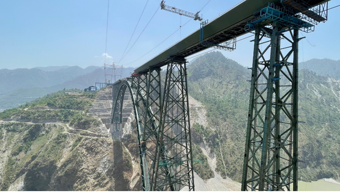
Bi-directional static load testing (BDSLT) by JF SME Testing is a highly effective static load testing technique that delivers accurate and reliable data.
BDSLT provides high resolution results for design engineers to confidently optimise pile design, based on achieved test results. In comparison to traditional methods of load testing, BDSLT is safer, faster and provides more accurate data. It is often the only solution for restricted access or low headroom situations where installation of anchor piles or other reaction systems are not possible.
Using a combination of hydraulic, high-capacity bi-directional jacks to deliver the required test load, BDSLT provides separate measurements of a pile’s end-bearing and skin friction along the pile’s length. JF SME Testing has utilised BDSLT for over 15 years, having successfully completed over 2,000 tests worldwide. During this time, JF SME Testing has refined the equipment used and techniques deployed on-site to ensure reliable and accurate results.
JF SME Testing's highly skilled testing team can provide a tailored service, using the latest innovative James Fisher products. JF SME Testing's global presence and depth of experience enables it to deliver a rapid response service for quick on-site evaluations and remote monitoring services.
Testing capabilities
BDSLT is suitable for a range of both commercial and non-commercial applications, including the assessment of cast in-situ piles for (but not limited to):
• Bridges
• Structures
• Railway lines
• High-rise housing
JF SME Testing's BDSLT method is fully compliant with the ASTM D8169 / D8169M – 18 standard.
HSE benefits
- Enhanced safety and reliability in comparison to traditional load testing methods
- No risk of oil contamination in the event of fluid spills during testing as standard mineral water is used for the hydraulic fluid
- Greatly reduced risk for larger test loads without the need to stack Kentledge blocks above the test pile (BDSLT loads in excess of 10,000T have been successfully achieved)
Cost benefits
- BDSLT eliminates the need for overhead beams or reaction piles making the test more mobile and space efficient in comparison to other methods
- Preparation for the installation of the pre-manufactured bi-directional hydraulic jack(s) can be completed within a few days, saving time on tight building schedules
- Proven to be more cost-effective as loads increase in comparison to traditional load testing methods due to the fixed costs of materials, jacks, plates and installation time
Time benefits
- Precision testing provides engineers with separate data on the end-bearing and friction resistance of the shaft BDSLT is a versatile method that can be applied to barrette, bored piles (compression or tension), inclined piles or belled shafts
- The test pile can be reused to carry working loads after testing by grouting the pile, creating value for money
- Installation process forms part of the rebar cage fabrication which speeds up installation time
- Minimal work space required during testing in comparison to conventional tests, meaning other works can continue on-site and at the same time
- No soil stabilisation is required prior to set-up/testing
- All test results are automated and streamed to a site laptop at a sampling rate of one per minute
- Only need to cast the pile to cut-off level, eliminating the need for a king post or hacking back a test pile when testing is complete
Set up
Hydraulic jacks are positioned between two load bearing plates and attached to the reinforced steel cage prior to lowering. Positioning is calculated to provide equal capacities above and below the hydraulic jack assembly. Concrete casting is performed as normal, with cube tests indicating when testing can commence. A full method statement is provided prior to installation to outline the test design and procedure.
During testing
Hydraulic pressure is applied to the jack assembly. As load is applied, the hydraulic jacks begin to move in two directions - upward against upper skin friction and downward against lower skin friction and base resistance. Types of tests include:
1. An ultimate load test (ULT) includes strain gauges installed along the pile length, with the pile being loaded until either the shear resistance or base resistance of the pile has been fully mobilised. Strain gauge data is used to plot the load distribution along the pile length which is used to determine the ultimate soil capacity of the test pile.
2. A working load test (WLT) loads the pile within the acceptable working load limits. This type of test is used to validate whether the pile head displacement for the given load conforms to the allowable pile head settlement criteria.
Post testing
Following test completion, a full test report is supplied including the obtained soil parameters and equivalent top loaded settlement values. Both documents can be sent for professional engineer endorsement, if required.
Test equipment supplied and utilised by JF SME Testing's experienced engineers, including:
- Combination of hydraulic jacks to apply the test load
- Steel bearing plates to position the hydraulic jacks
- Displacement transducers, connected to tell-tale rods
- Strain gauges installed along pile length
- Fully automated data logger to monitor and record the data signals
- JF SME Testing's pileSENTINEL software to visually display live readings throughout testing
JF SME Testing bi-directional static load test (BDSLT)
JF SME Testing's bi-directional static load test (BDSLT) is a truly innovative and highly effective static load testing technique. The speed and accuracy of the testing method has made BDSLT a valuable tool and the wealth of information produced is the reason so many engineers are now turning to this method.

If you are making an enquiry about a product or service, please use our sales enquiry form.
Read our latest news
 Read article
Read article
Sale of Mimic and Strainstall UK
Read article
JF SME Testing provides structural health monitoring system for the world’s tallest railway bridge
Read article
JF SME Testing secures Places of Westminster instrumentation and monitoring contract
Read article
James Fisher combines its asset monitoring capabilities under the new brand of JF SME Testing
Read article
All Monitoring Data in One Platform
Read article
Detection of bridge impact
Read article
Monitoring Railway for Washout
Read article



